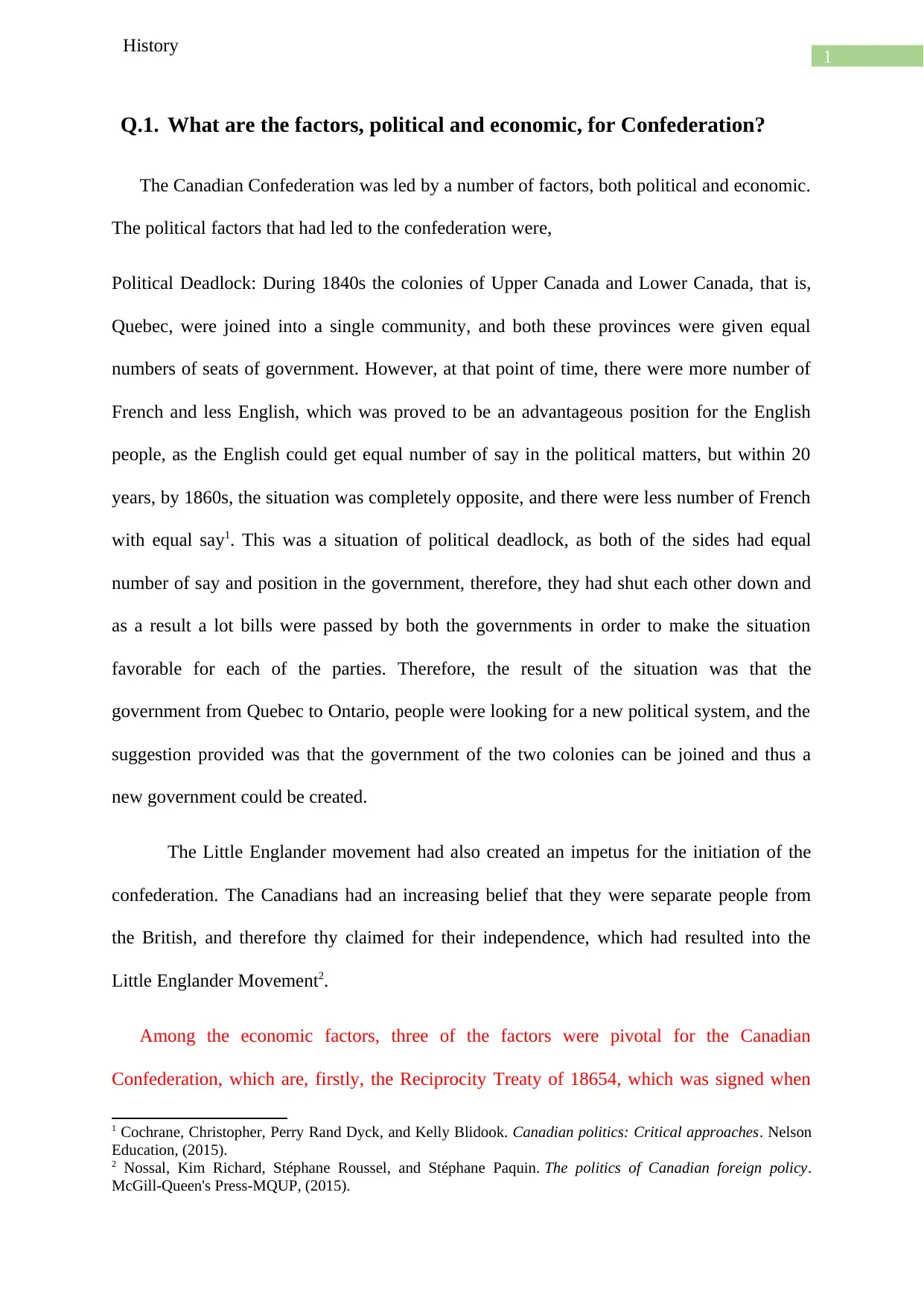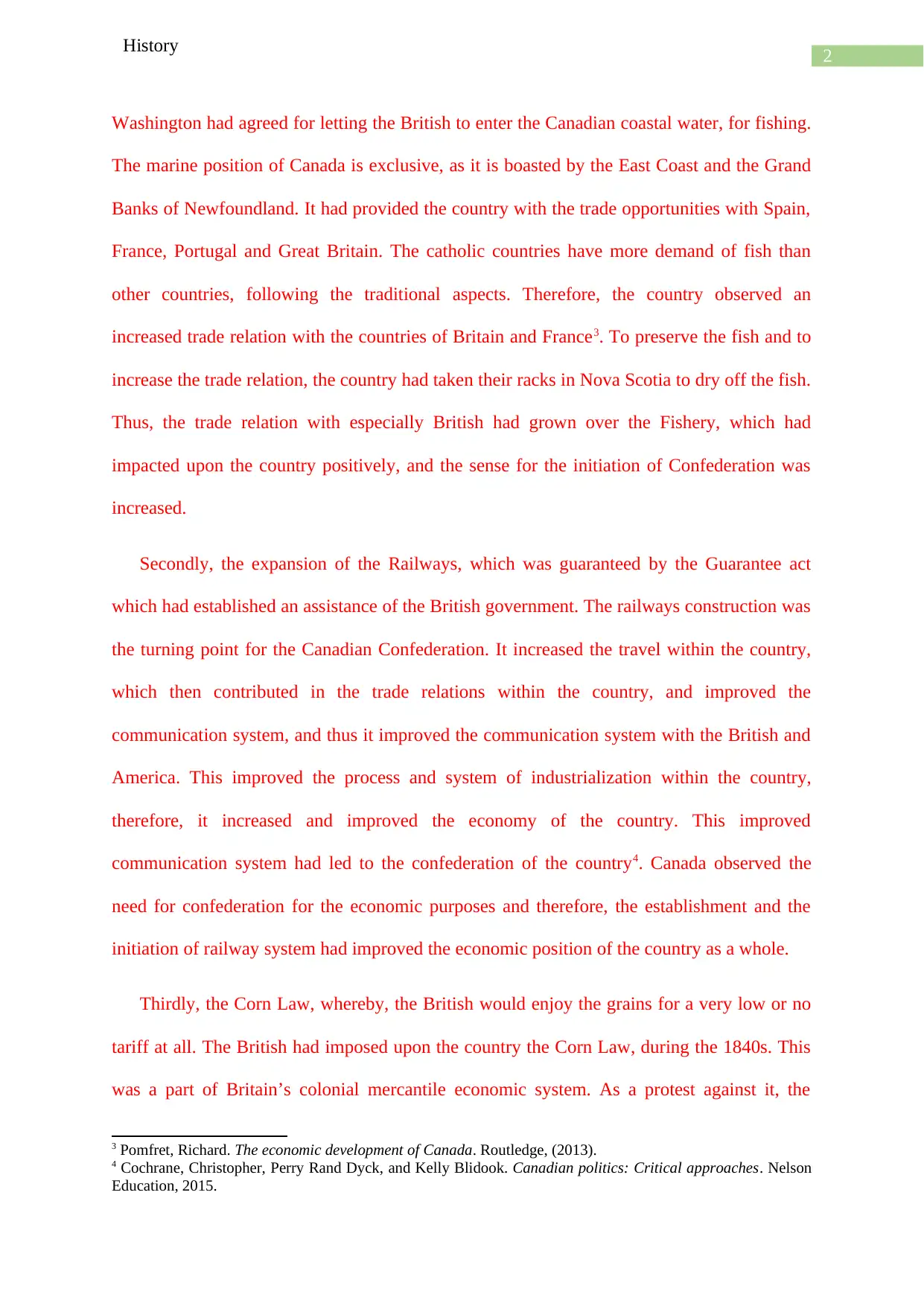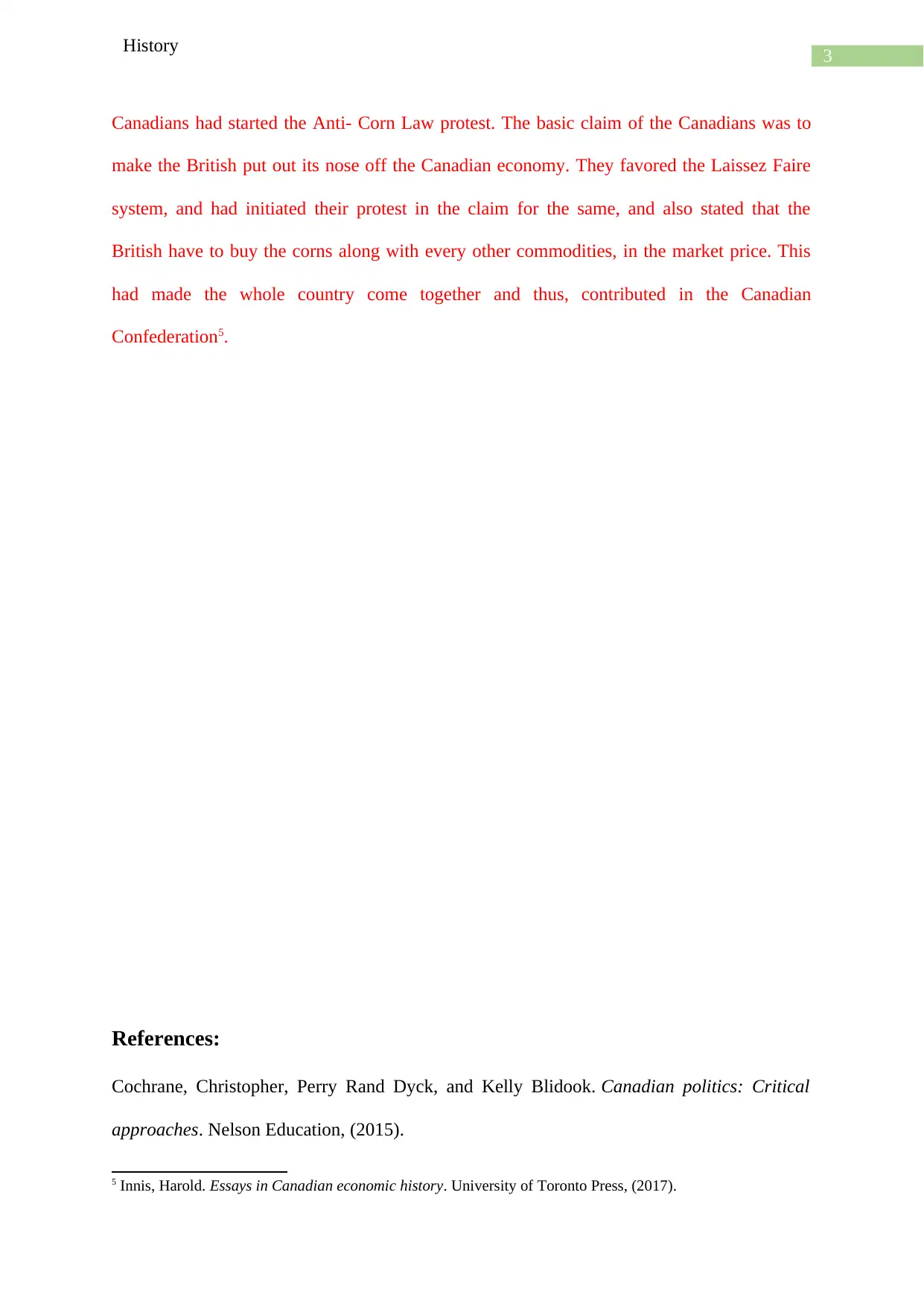Political and Economic Drivers of the Canadian Confederation Process
VerifiedAdded on 2022/12/03
|5
|941
|368
Essay
AI Summary
This essay analyzes the political and economic factors that led to the Canadian Confederation. Politically, the essay discusses the political deadlock between Upper and Lower Canada, the rise of the Little Englander movement, and the push for independence from Britain. Economically, the essay examines the impact of the Reciprocity Treaty of 1854, the expansion of railways, and the Corn Law. The Reciprocity Treaty facilitated trade, particularly in the fishing industry, while railway expansion improved internal trade and communication. The Corn Law and the subsequent anti-Corn Law protests highlighted the desire for economic autonomy. The essay argues that these factors collectively created an environment conducive to Confederation, driven by the need for a new political system and improved economic opportunities. The essay references various academic sources to support its claims.

Running head: HISTORY
History
Name of the University:
Name of the Student:
Assignment Number:
Author Note:
History
Name of the University:
Name of the Student:
Assignment Number:
Author Note:
Paraphrase This Document
Need a fresh take? Get an instant paraphrase of this document with our AI Paraphraser

1
History
Q.1. What are the factors, political and economic, for Confederation?
The Canadian Confederation was led by a number of factors, both political and economic.
The political factors that had led to the confederation were,
Political Deadlock: During 1840s the colonies of Upper Canada and Lower Canada, that is,
Quebec, were joined into a single community, and both these provinces were given equal
numbers of seats of government. However, at that point of time, there were more number of
French and less English, which was proved to be an advantageous position for the English
people, as the English could get equal number of say in the political matters, but within 20
years, by 1860s, the situation was completely opposite, and there were less number of French
with equal say1. This was a situation of political deadlock, as both of the sides had equal
number of say and position in the government, therefore, they had shut each other down and
as a result a lot bills were passed by both the governments in order to make the situation
favorable for each of the parties. Therefore, the result of the situation was that the
government from Quebec to Ontario, people were looking for a new political system, and the
suggestion provided was that the government of the two colonies can be joined and thus a
new government could be created.
The Little Englander movement had also created an impetus for the initiation of the
confederation. The Canadians had an increasing belief that they were separate people from
the British, and therefore thy claimed for their independence, which had resulted into the
Little Englander Movement2.
Among the economic factors, three of the factors were pivotal for the Canadian
Confederation, which are, firstly, the Reciprocity Treaty of 18654, which was signed when
1 Cochrane, Christopher, Perry Rand Dyck, and Kelly Blidook. Canadian politics: Critical approaches. Nelson
Education, (2015).
2 Nossal, Kim Richard, Stéphane Roussel, and Stéphane Paquin. The politics of Canadian foreign policy.
McGill-Queen's Press-MQUP, (2015).
History
Q.1. What are the factors, political and economic, for Confederation?
The Canadian Confederation was led by a number of factors, both political and economic.
The political factors that had led to the confederation were,
Political Deadlock: During 1840s the colonies of Upper Canada and Lower Canada, that is,
Quebec, were joined into a single community, and both these provinces were given equal
numbers of seats of government. However, at that point of time, there were more number of
French and less English, which was proved to be an advantageous position for the English
people, as the English could get equal number of say in the political matters, but within 20
years, by 1860s, the situation was completely opposite, and there were less number of French
with equal say1. This was a situation of political deadlock, as both of the sides had equal
number of say and position in the government, therefore, they had shut each other down and
as a result a lot bills were passed by both the governments in order to make the situation
favorable for each of the parties. Therefore, the result of the situation was that the
government from Quebec to Ontario, people were looking for a new political system, and the
suggestion provided was that the government of the two colonies can be joined and thus a
new government could be created.
The Little Englander movement had also created an impetus for the initiation of the
confederation. The Canadians had an increasing belief that they were separate people from
the British, and therefore thy claimed for their independence, which had resulted into the
Little Englander Movement2.
Among the economic factors, three of the factors were pivotal for the Canadian
Confederation, which are, firstly, the Reciprocity Treaty of 18654, which was signed when
1 Cochrane, Christopher, Perry Rand Dyck, and Kelly Blidook. Canadian politics: Critical approaches. Nelson
Education, (2015).
2 Nossal, Kim Richard, Stéphane Roussel, and Stéphane Paquin. The politics of Canadian foreign policy.
McGill-Queen's Press-MQUP, (2015).

2
History
Washington had agreed for letting the British to enter the Canadian coastal water, for fishing.
The marine position of Canada is exclusive, as it is boasted by the East Coast and the Grand
Banks of Newfoundland. It had provided the country with the trade opportunities with Spain,
France, Portugal and Great Britain. The catholic countries have more demand of fish than
other countries, following the traditional aspects. Therefore, the country observed an
increased trade relation with the countries of Britain and France3. To preserve the fish and to
increase the trade relation, the country had taken their racks in Nova Scotia to dry off the fish.
Thus, the trade relation with especially British had grown over the Fishery, which had
impacted upon the country positively, and the sense for the initiation of Confederation was
increased.
Secondly, the expansion of the Railways, which was guaranteed by the Guarantee act
which had established an assistance of the British government. The railways construction was
the turning point for the Canadian Confederation. It increased the travel within the country,
which then contributed in the trade relations within the country, and improved the
communication system, and thus it improved the communication system with the British and
America. This improved the process and system of industrialization within the country,
therefore, it increased and improved the economy of the country. This improved
communication system had led to the confederation of the country4. Canada observed the
need for confederation for the economic purposes and therefore, the establishment and the
initiation of railway system had improved the economic position of the country as a whole.
Thirdly, the Corn Law, whereby, the British would enjoy the grains for a very low or no
tariff at all. The British had imposed upon the country the Corn Law, during the 1840s. This
was a part of Britain’s colonial mercantile economic system. As a protest against it, the
3 Pomfret, Richard. The economic development of Canada. Routledge, (2013).
4 Cochrane, Christopher, Perry Rand Dyck, and Kelly Blidook. Canadian politics: Critical approaches. Nelson
Education, 2015.
History
Washington had agreed for letting the British to enter the Canadian coastal water, for fishing.
The marine position of Canada is exclusive, as it is boasted by the East Coast and the Grand
Banks of Newfoundland. It had provided the country with the trade opportunities with Spain,
France, Portugal and Great Britain. The catholic countries have more demand of fish than
other countries, following the traditional aspects. Therefore, the country observed an
increased trade relation with the countries of Britain and France3. To preserve the fish and to
increase the trade relation, the country had taken their racks in Nova Scotia to dry off the fish.
Thus, the trade relation with especially British had grown over the Fishery, which had
impacted upon the country positively, and the sense for the initiation of Confederation was
increased.
Secondly, the expansion of the Railways, which was guaranteed by the Guarantee act
which had established an assistance of the British government. The railways construction was
the turning point for the Canadian Confederation. It increased the travel within the country,
which then contributed in the trade relations within the country, and improved the
communication system, and thus it improved the communication system with the British and
America. This improved the process and system of industrialization within the country,
therefore, it increased and improved the economy of the country. This improved
communication system had led to the confederation of the country4. Canada observed the
need for confederation for the economic purposes and therefore, the establishment and the
initiation of railway system had improved the economic position of the country as a whole.
Thirdly, the Corn Law, whereby, the British would enjoy the grains for a very low or no
tariff at all. The British had imposed upon the country the Corn Law, during the 1840s. This
was a part of Britain’s colonial mercantile economic system. As a protest against it, the
3 Pomfret, Richard. The economic development of Canada. Routledge, (2013).
4 Cochrane, Christopher, Perry Rand Dyck, and Kelly Blidook. Canadian politics: Critical approaches. Nelson
Education, 2015.
⊘ This is a preview!⊘
Do you want full access?
Subscribe today to unlock all pages.

Trusted by 1+ million students worldwide

3
History
Canadians had started the Anti- Corn Law protest. The basic claim of the Canadians was to
make the British put out its nose off the Canadian economy. They favored the Laissez Faire
system, and had initiated their protest in the claim for the same, and also stated that the
British have to buy the corns along with every other commodities, in the market price. This
had made the whole country come together and thus, contributed in the Canadian
Confederation5.
References:
Cochrane, Christopher, Perry Rand Dyck, and Kelly Blidook. Canadian politics: Critical
approaches. Nelson Education, (2015).
5 Innis, Harold. Essays in Canadian economic history. University of Toronto Press, (2017).
History
Canadians had started the Anti- Corn Law protest. The basic claim of the Canadians was to
make the British put out its nose off the Canadian economy. They favored the Laissez Faire
system, and had initiated their protest in the claim for the same, and also stated that the
British have to buy the corns along with every other commodities, in the market price. This
had made the whole country come together and thus, contributed in the Canadian
Confederation5.
References:
Cochrane, Christopher, Perry Rand Dyck, and Kelly Blidook. Canadian politics: Critical
approaches. Nelson Education, (2015).
5 Innis, Harold. Essays in Canadian economic history. University of Toronto Press, (2017).
Paraphrase This Document
Need a fresh take? Get an instant paraphrase of this document with our AI Paraphraser

4
History
Innis, Harold. Essays in Canadian economic history. University of Toronto Press, (2017).
Lipset, Seymour Martin. Continental divide: The values and institutions of the United States
and Canada. Routledge, (2013).
Nossal, Kim Richard, Stéphane Roussel, and Stéphane Paquin. The politics of Canadian
foreign policy. McGill-Queen's Press-MQUP, (2015).
Pomfret, Richard. The economic development of Canada. Routledge, (2013).
Cochrane, Christopher, Perry Rand Dyck, and Kelly Blidook. Canadian politics: Critical
approaches. Nelson Education, (2015).
History
Innis, Harold. Essays in Canadian economic history. University of Toronto Press, (2017).
Lipset, Seymour Martin. Continental divide: The values and institutions of the United States
and Canada. Routledge, (2013).
Nossal, Kim Richard, Stéphane Roussel, and Stéphane Paquin. The politics of Canadian
foreign policy. McGill-Queen's Press-MQUP, (2015).
Pomfret, Richard. The economic development of Canada. Routledge, (2013).
Cochrane, Christopher, Perry Rand Dyck, and Kelly Blidook. Canadian politics: Critical
approaches. Nelson Education, (2015).
1 out of 5
Related Documents
Your All-in-One AI-Powered Toolkit for Academic Success.
+13062052269
info@desklib.com
Available 24*7 on WhatsApp / Email
![[object Object]](/_next/static/media/star-bottom.7253800d.svg)
Unlock your academic potential
Copyright © 2020–2025 A2Z Services. All Rights Reserved. Developed and managed by ZUCOL.





